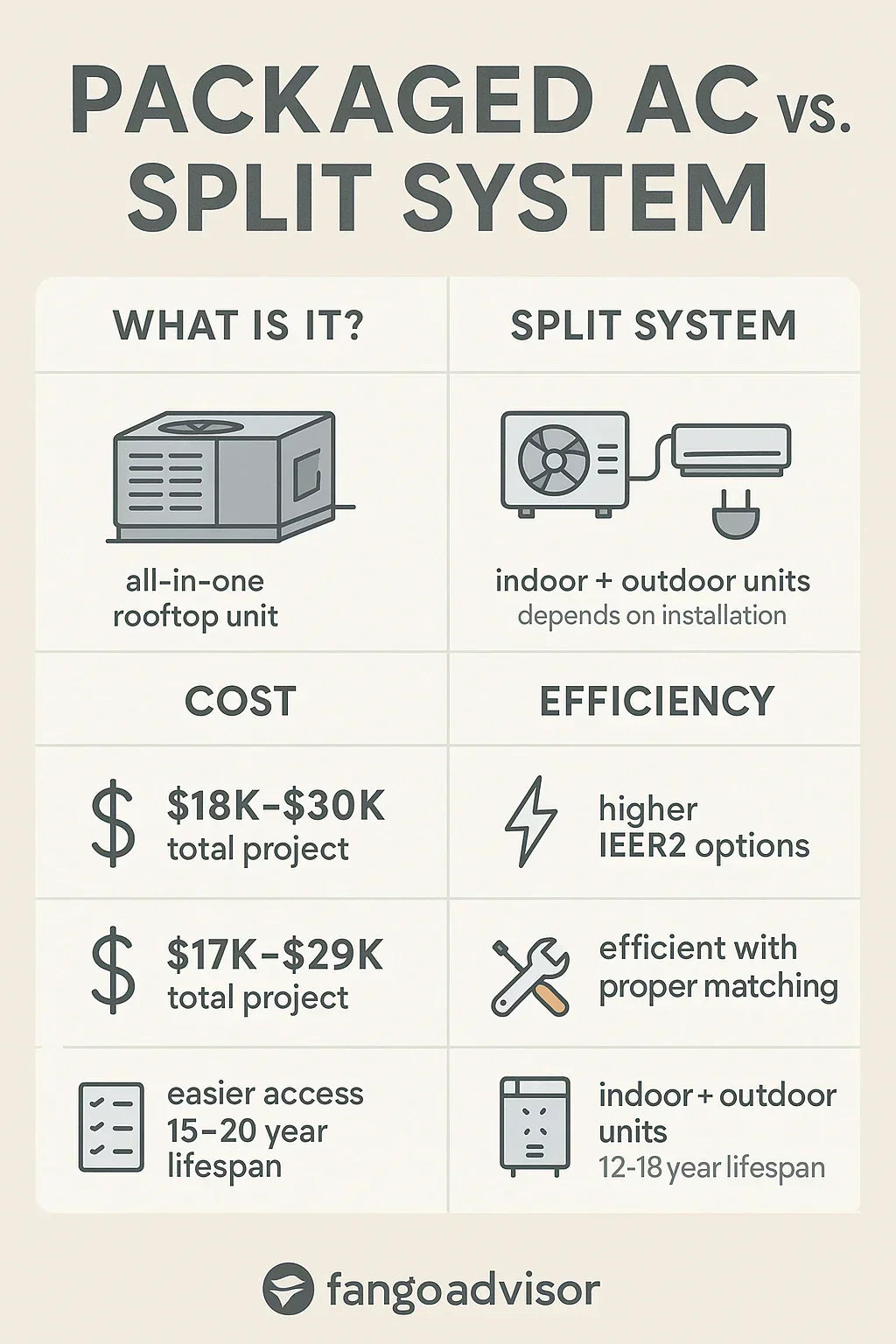When it comes to cooling a commercial building, the choice often comes down to two systems: a packaged rooftop unit (RTU) or a split system. Both are proven technologies, both can deliver comfort and efficiency—but they differ in cost, design, installation, maintenance, and ROI.
Daikin 10 Ton 208/230-3-60V 15 IEER2 Light Commercial Packaged Air Conditioner - DFC1203D000001S
Choosing the wrong system can cost thousands in wasted installation expenses, higher monthly bills, or premature equipment failure. Choosing wisely ensures lower total cost of ownership, better comfort, and reliable long-term performance.
This guide provides a detailed breakdown to help business owners, facility managers, and developers make the right call.
📦 1. What is a Packaged AC?
A packaged air conditioner (often called a rooftop unit or RTU) combines all the key components—compressor, condenser, evaporator coil, blower, and controls—into one cabinet.
Features:
-
Typically mounted on the roof or ground pad outside.
-
Single unit supplies air through ductwork to the building.
-
Often gas/electric hybrid models for heating + cooling.
Benefits:
-
All-in-one design → easier installation.
-
Frees up indoor space (no indoor air handler).
-
Ideal for medium-to-large commercial buildings.
📖 Reference: Daikin Applied – Rooftop Packaged Units
🏗️ 2. What is a Split System?
A split system separates the major components:
-
Outdoor unit: houses the compressor and condenser.
-
Indoor unit: contains the evaporator coil and blower.
-
Connected by refrigerant lines and ductwork.
Features:
-
More flexible installation (outdoor unit doesn’t need roof access).
-
Scalable—multiple split systems can serve different zones.
Benefits:
-
Common in small offices, retail, medical clinics.
-
Easier to retrofit in older buildings with no roof curb.
📖 Reference: Carrier – Commercial Split Systems
💵 3. Cost Comparison: Packaged vs. Split
Cost is often the deciding factor. Let’s break it down.
| Category | Packaged AC (10-ton RTU) | Split System (10-ton equivalent) |
|---|---|---|
| Equipment | $12,000–$18,000 | $10,000–$15,000 |
| Installation | $6,000–$12,000 | $7,000–$14,000 |
| Total Project | $18,000–$30,000 | $17,000–$29,000 |
Why the Overlap?
-
Packaged ACs require cranes + roof prep.
-
Split systems require extra ductwork + refrigerant lines.
👉 In many cases, installed cost is nearly the same—the real difference comes in operating efficiency, maintenance, and lifespan.
📖 Reference: HVAC Cost Guide
⚡ 4. Energy Efficiency & Operating Costs
Operating costs are where ROI really shows up.
Packaged AC Efficiency
-
Governed by IEER2 (Integrated Energy Efficiency Ratio 2).
-
High-end models (like Daikin 15 IEER2) save 20%+ energy vs. baseline units.
-
ENERGY STAR requires IEER2 ≥ 15.0 in 2025.
Split System Efficiency
-
Measured in SEER2 and IEER2.
-
Can be highly efficient—but performance depends on matching indoor + outdoor units correctly.
-
Efficiency can degrade if components are mismatched.
Cost Example:
-
Old 10 IEER unit → ~$12,000/year in cooling costs.
-
New Daikin 15 IEER2 RTU → ~$9,000/year.
-
Annual savings = $3,000.
📖 Reference: ENERGY STAR – Commercial HVAC
🧾 5. Maintenance & Lifespan
Packaged AC
-
All components in one cabinet → easy access for service.
-
Typical lifespan: 15–20 years.
-
Maintenance: $1,500–$3,000/year (filters, coils, refrigerant checks).
Split System
-
Indoor + outdoor units require separate servicing.
-
More refrigerant line connections = more leak risks.
-
Typical lifespan: 12–18 years.
-
Maintenance: $1,800–$3,500/year (slightly higher due to dual servicing).
📖 Reference: ASHRAE – Preventive Maintenance Standards
🏢 6. Which System Fits Your Business?
Here’s a breakdown by business type:
Best for Packaged ACs
-
Offices (10,000+ sq. ft.) → central cooling, low indoor noise.
-
Restaurants → frees up kitchen space.
-
Warehouses → fewer indoor components exposed to dust.
-
Retail → rooftop placement maximizes floor space.
Best for Split Systems
-
Small retail shops → flexible placement, smaller footprint.
-
Medical clinics → zoned cooling, independent temperature control.
-
Retrofit projects → no need for roof access.
-
Mixed-use buildings → scalable for different zones.
📈 7. ROI Comparison
Let’s look at a 10-year ownership cost.
Packaged AC (10-ton, Daikin 15 IEER2)
-
Installed cost: $25,000
-
Annual operating cost: $9,000
-
Annual maintenance: $2,000
-
10-year total = $115,000
Split System (10-ton equivalent)
-
Installed cost: $24,000
-
Annual operating cost: $9,500
-
Annual maintenance: $2,200
-
10-year total = $119,000
👉 Over 10 years, the packaged AC saves $4,000+ and is easier to maintain.
🎁 Incentives & Rebates
Both packaged and split systems may qualify for:
-
Section 179D deduction (up to $5/sq. ft. for efficiency upgrades).
-
Utility rebates ($500–$2,500 per unit).
-
IRA commercial credits (if efficiency exceeds ASHRAE standards).
📖 Reference: DSIRE – Energy Incentives Database
🏆 Key Takeaways
-
Packaged ACs → best for larger businesses, longer lifespan, easier maintenance, strong ROI.
-
Split systems → best for smaller buildings, retrofit flexibility, zone control.
-
Installed costs are similar—ROI depends on operating efficiency and serviceability.
-
With federal + state incentives, high-efficiency packaged ACs often deliver faster payback.
👉 If your business has rooftop space and wants a low-hassle, long-term solution, a packaged AC is usually the smarter choice.
In the next topic we will know more about: Noise Levels and Comfort: What to Expect from a Daikin 10-Ton System







